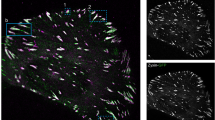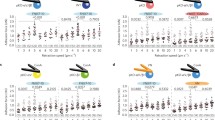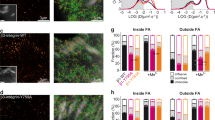Abstract
Cells dynamically interact with their physical micro-environment through the assembly of nascent focal contacts and focal adhesions. The dynamics and mechanics of these contact points are controlled by transmembrane integrins and an array of intracellular adaptor proteins. In order to study the mechanics and dynamics of focal adhesion assembly, we have developed a technique for the timed induction of a nascent focal adhesion. Bovine aortic endothelial cells were approached at the apical surface by a nanoelectrode whose position was controlled with a resolution of 10 s of nanometers using changes in electrode current to monitor distance from the cell surface. Since this probe was functionalized with fibronectin, a focal contact formed at the contact location. Nascent focal adhesion assembly was confirmed using time-lapse confocal fluorescent images of red fluorescent protein—tagged talin, an adapter protein that binds to activated integrins. Binding to the cell was verified by noting a lack of change of electrode current upon retraction of the electrode. This study demonstrates that functionalized nanoelectrodes can enable precisely-timed induction and 3-D mechanical manipulation of focal adhesions and the assay of the detailed molecular kinetics of their assembly.







Similar content being viewed by others
References
Anthis, N. J., K. L. Wegener, F. Ye, C. Kim, B. T. Goult, E. D. Lowe, I. Vakonakis, N. Bate, D. R. Critchley, M. H. Ginsberg, and I. D. Campbell. The structure of an integrin/talin complex reveals the basis of inside-out signal transduction. EMBO J. 28:3623–3632, 2009.
Ashkin, A., J. M. Dziedzic, and T. Yamane. Optical trapping and manipulation of single cells using infrared laser beams. Nature 330:769–771, 1987.
Askari, J. A., P. A. Buckley, A. P. Mould, and M. J. Humphries. Linking integrin conformation to function. J. Cell Sci. 122:165–170, 2009.
Baneyx, G., L. Baugh, and V. Vogel. Fibronectin extension and unfolding within cell matrix fibrils controlled by cytoskeletal tension. Proc. Natl Acad. Sci. 99:5139–5143, 2002.
Bell, G. I. Models for the specific adhesion of cells to cells. Science 200:618–627, 1978.
Binnig, G., C. F. Quate, and C. Gerber. Atomic force microscope. Phys. Rev. Lett. 56:930–933, 1986.
Bouaouina, M., Y. Lad, and D. A. Calderwood. The N-terminal domains of talin cooperate with the phosphotyrosine binding-like domain to activate beta1 and beta3 integrins. J. Biol. Chem. 283:6118–6125, 2008.
Butcher, D. T., T. Alliston, and V. M. Weaver. A tense situation: forcing tumour progression. Nat. Rev. Cancer 9:108–122, 2009.
Calderwood, D. A. Integrin activation. J. Cell Sci. 117:657–666, 2004.
Campbell, I. D., and M. H. Ginsberg. The talin-tail interaction places integrin activation on FERM ground. Trends Biochem. Sci. 29:429–435, 2004.
Castelain, M., F. Pignon, J. M. Piau, A. Magnin, M. Mercier-Bonin, and P. Schmitz. Removal forces and adhesion properties of Saccharomyces cerevisiae on glass substrates probed by optical tweezer. J. Chem. Phys. 127:135104, 2007.
Celedon, A., I. M. Nodelman, B. Wildt, R. Dewan, P. Searson, D. Wirtz, G. D. Bowman, and S. X. Sun. Magnetic tweezers measurement of single molecule torque. Nano. Lett. 9:1720–1725, 2009.
Chen, S., and T. A. Springer. Selectin receptor ligand bonds: formation limited by shear rate and dissociation governed by the Bell model. Proc. Natl Acad. Sci. 98:950–955, 2001.
Chiou, C. H. A micromachined DNA manipulation platform for the stretching and rotation of a single DNA molecule. J. Micromech. Microeng. 15:109, 2005.
Choquet, D., D. P. Felsenfeld, and M. P. Sheetz. Extracellular matrix rigidity causes strengthening of integrin-cytoskeleton linkages. Cell 88:39–48, 1997.
Cluzel, P., A. Lebrun, C. Heller, R. Lavery, J. L. Viovy, D. Chatenay, and F. Caron. DNA: an extensible molecule. Science 271:792–794, 1996.
Critchley, D. R., and A. R. Gingras. Talin at a glance. J. Cell Sci. 121:1345–1347, 2008.
Danilowicz, C., D. Greenfield, and M. Prentiss. Dissociation of ligand-receptor complexes using magnetic tweezers. Anal. Chem. 77:3023–3028, 2005.
Davies, P. F., J. Zilberberg, and B. P. Helmke. Spatial microstimuli in endothelial mechanosignaling. Circ. Res. 92:359–370, 2003.
de Pereda, J. M., K. L. Wegener, E. Santelli, N. Bate, M. H. Ginsberg, D. R. Critchley, I. D. Campbell, and R. C. Liddington. Structural basis for phosphatidylinositol phosphate kinase type Igamma binding to talin at focal adhesions. J. Biol. Chem. 280:8381–8386, 2005.
Eibl, R. H., and V. T. Moy. Atomic force microscopy measurements of protein-ligand interactions on living cells. Methods Mol. Biol. 305:439–449, 2005.
Evans, E., K. Ritchie, and R. Merkel. Sensitive force technique to probe molecular adhesion and structural linkages at biological interfaces. Biophys. J. 68:2580–2587, 1995.
Garcia-Alvarez, B., J. M. de Pereda, D. A. Calderwood, T. S. Ulmer, D. Critchley, I. D. Campbell, M. H. Ginsberg, and R. C. Liddington. Structural determinants of integrin recognition by talin. Mol. Cell. 11:49–58, 2003.
Geiger, B., J. P. Spatz, and A. D. Bershadsky. Environmental sensing through focal adhesions. Nat. Rev. Mol. Cell Biol. 10:21–33, 2009.
Gorelik, J., Y. Zhang, A. I. Shevchuk, G. I. Frolenkov, D. Sanchez, M. J. Lab, I. Vodyanoy, C. R. W. Edwards, D. Klenerman, and Y. E. Korchev. The use of scanning ion conductance microscopy to image A6 cells. Mol. Cell. Endocrinol. 217:101–108, 2004.
Gosse, C., and V. Croquette. Magnetic tweezers: micromanipulation and force measurement at the molecular level. Biophys. J. 82:3314–3329, 2002.
Gosse, C., and V. Croquette. Magnetic tweezers: micromanipulation and force measurement at the molecular level. Biophys. J. 82:3314–3329, 2002.
Hansma, P., B. Drake, O. Marti, S. Gould, and C. Prater. The scanning ion-conductance microscope. Science 243:641–643, 1989.
Hassan, E., W. F. Heinz, M. D. Antonik, N. P. D’Costa, S. Nageswaran, C. A. Schoenenberger, and J. H. Hoh. Relative microelastic mapping of living cells by atomic force microscopy. Biophys. J. 74:1564–1578, 1998.
Huang, H., R. D. Kamm, and R. T. Lee. Cell mechanics and mechanotransduction: pathways, probes, and physiology. Am. J. Physiol. Cell Physiol. 287:C1–C11, 2004.
Kegler, K., M. Salomo, and F. Kremer. Forces of interaction between DNA-grafted colloids: an optical tweezer measurement. Phys. Rev. Lett. 98:058304, 2007.
Koay, E. J., A. C. Shieh, and K. A. Athanasiou. Creep indentation of single cells. J. Biomech. Eng. 125:334–341, 2003.
Konstantopoulos, K., W. D. Hanley, and D. Wirtz. Receptor-ligand binding: [`]catch’ bonds finally caught. Curr. Biol. 13:R611–R613, 2003.
Korchev, Y., C. Bashford, M. Milovanovic, I. Vodyanoy, and M. Lab. Scanning ion conductance microscopy of living cells. Biophys. J. 73:653–658, 1997.
Leipzig, N. D., and K. A. Athanasiou. Unconfined creep compression of chondrocytes. J. Biomech. 38:77–85, 2005.
Lele, T. P., C. K. Thodeti, and D. E. Ingber. Force meets chemistry: Analysis of mechanochemical conversion in focal adhesions using fluorescence recovery after photobleaching. J. Cell. Biochem. 97:1175–1183, 2006.
Marshall, B. T., M. Long, J. W. Piper, T. Yago, R. P. McEver, and C. Zhu. Direct observation of catch bonds involving cell-adhesion molecules. Nature 423:190–193, 2003.
Mathur, A. B., G. A. Truskey, and W. Monty Reichert. Total internal reflection microscopy and atomic force microscopy (TIRFM-AFM) to study stress transduction mechanisms in endothelial cells. Crit. Rev. Biomed. Eng. 28:197–202, 2000.
Mathur, A. B., G. A. Truskey, and W. Monty Reichert. Atomic force and total internal reflection fluorescence microscopy for the study of force transmission in endothelial cells. Biophys. J. 78:1725–1735, 2000.
Matthews, B. D., D. R. Overby, F. J. Alenghat, J. Karavitis, Y. Numaguchi, P. G. Allen, and D. E. Ingber. Mechanical properties of individual focal adhesions probed with a magnetic microneedle. Biochem. Biophys. Res. Commun. 313:758–764, 2004.
Moffitt, J. R., Y. R. Chemla, D. Izhaky, and C. Bustamante. Differential detection of dual traps improves the spatial resolution of optical tweezers. Proc. Natl Acad. Sci. USA. 103:9006–9011, 2006.
Neuman, K. C., and A. Nagy. Single-molecule force spectroscopy: optical tweezers, magnetic tweezers and atomic force microscopy. Nat. Methods 5:491–505, 2008.
Ohayon, J., P. Tracqui, R. Fodil, S. Fereol, V. M. Laurent, E. Planus, and D. Isabey. Analysis of nonlinear responses of adherent epithelial cells probed by magnetic bead twisting: a finite element model based on a homogenization approach. J. Biomech. Eng. 126:685–698, 2004.
Orr, A. W., B. P. Helmke, B. R. Blackman, and M. A. Schwartz. Mechanisms of mechanotransduction. Dev. Cell 10:11–20, 2006.
Panhorst, M., P. B. Kamp, G. Reiss, and H. Bruckl. Sensitive bondforce measurements of ligand-receptor pairs with magnetic beads. Biosens. Bioelectron. 20:1685–1689, 2005.
Peterman, E. J. G., F. Gittes, and C. F. Schmidt. Laser-induced heating in optical traps. Biophys. J. 84:1308–1316, 2003.
Radmacher, M. Measuring the elastic properties of biological samples with the AFM. IEEE Eng. Med. Biol. Mag. 16:47–57, 1997.
Rief, M., F. Oesterhelt, B. Heymann, and H. E. Gaub. Single molecule force spectroscopy on polysaccharides by atomic force microscopy. Science 275:1295–1297, 1997.
Riveline, D., E. Zamir, N. Q. Balaban, U. S. Schwarz, T. Ishizaki, S. Narumiya, Z. Kam, B. Geiger, and A. D. Bershadsky. Focal contacts as mechanosensors: externally applied local mechanical force induces growth of focal contacts by an mDia1-dependent and ROCK-independent mechanism. J. Cell Biol. 153:1175–1186, 2001.
Roichman, Y., V. Wong, and D. G. Grier. Colloidal transport through optical tweezer arrays. Phys. Rev. E. Stat. Nonlin. Soft. Matter Phys. 75:011407, 2007.
Rotsch, C., and M. Radmacher. Drug-Induced changes of cytoskeletal structure and mechanics in fibroblasts: an atomic force microscopy study. Biophys. J. 78:520–535, 2000.
Sawada, Y., and M. P. Sheetz. Force transduction by Triton cytoskeletons. J. Cell Biol. 156:609–615, 2002.
Seol, Y., A. E. Carpenter, and T. T. Perkins. Gold nanoparticles: enhanced optical trapping and sensitivity coupled with significant heating. Opt. Lett. 31:2429–2431, 2006.
Snyder, K. V., A. M. Kriegstein, and F. Sachs. A convenient electrode holder for glass pipettes to stabilize electrode potentials. Pflugers Arch. 438:405–411, 1999.
Tadokoro, S., S. J. Shattil, K. Eto, V. Tai, R. C. Liddington, J. M. de Pereda, M. H. Ginsberg, and D. A. Calderwood. Talin binding to integrin beta tails: a final common step in integrin activation. Science 302:103–106, 2003.
Tanase, M., N. Biais, and M. Sheetz. Magnetic tweezers in cell biology. Methods Cell Biol. 83:473–493, 2007.
Wang, Y., E. L. Botvinick, Y. Zhao, M. W. Berns, S. Usami, R. Y. Tsien, and S. Chien. Visualizing the mechanical activation of Src. Nature 434:1040–1045, 2005.
Wolenski, J. S., R. E. Cheney, M. S. Mooseker, and P. Forscher. In vitro motility of immunoadsorbed brain myosin-V using a Limulus acrosomal process and optical tweezer-based assay. J. Cell Sci. 108(Pt 4):1489–1496, 1995.
Author information
Authors and Affiliations
Corresponding author
Additional information
Associate Editor Edward Guo oversaw the review of this article.
Rights and permissions
About this article
Cite this article
Fuentes, D.E., Bae, C. & Butler, P.J. Focal Adhesion Induction at the Tip of a Functionalized Nanoelectrode. Cel. Mol. Bioeng. 4, 616–626 (2011). https://doi.org/10.1007/s12195-011-0214-7
Received:
Accepted:
Published:
Issue Date:
DOI: https://doi.org/10.1007/s12195-011-0214-7




